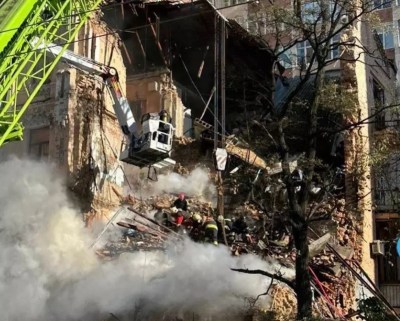
Iran’s decision to supply Russia with kamikaze drones and short-range ballistic missiles for use against Ukraine has brought the Islamic Republic’s firepower to the streets of European cities. The Iranian drone technology being used against Kiev has been in the hands of proxy militias across the Middle East for a number of years, where Tehran has tested and refined its weaponry.
Aside from showing off its drone arsenal and cementing relations with Moscow, Iran’s involvement in Ukraine is Tehran’s way of putting the West on notice that were it to squeeze the regime further through sanctions and by failing to conclude a nuclear deal, Iran has the capability to create problems far beyond the Middle East.
Iran will closely study the extent to which Western-made anti-missile systems have been able to thwart the Shahed-136 drones deployed by Russia against Ukraine.
Ukraine’s Western backers have struggled to come up with an integrated solution against the kamikaze drones that combines radars and electronic warfare systems with sophisticated anti-missile systems like the American Patriots, which the US has not yet made available to Kiev.
Moreover, the Iranian drones are slower and can fly at lower altitudes, making them more difficult to detect, as existing air defense systems are designed for bulkier airborne weapons. Still, Ukraine claims to have shot down 300 drones since mid-September, but at the great cost of using expensive air defenses and scrambling jets against a relatively cheap weapon.
Iran has also reportedly sent technical advisers to Crimea to assist Russian drone operators. By inserting its own nationals into the conflict, Tehran seems to have gone beyond a supplier-buyer relationship.
Iran has probably realized that were Russia to lose the war, that would imperil President Vladimir Putin’s hold on power. This is risky for Iran, as Russia provides it with much-needed diplomatic support at the United Nations and allows Tehran to maintain a presence in Syria.
Russia is also a key partner for Tehran’s existing nuclear plants. Putin has already signaled a break with the existing international order by hinting at the use of nuclear weapons on the battlefield. At this point, it is quite possible that Moscow may actively aid Tehran in the pursuit of a nuclear weapons should discussions to revive the 2015 Joint Comprehensive Plan of Action (JCPOA) fail.
Iran has thrown down the gauntlet to its regional rivals, which have sought to create a regional air defense system as a byproduct of the Abraham Accords. The regime in Tehran must be watching with glee as Israel struggles to support Ukraine wholeheartedly.
Indeed, just as Tehran has been publicly ambiguous about supporting Russia because Iranians have a skeptical view of Russia’s invasion of Ukraine, an Israeli government heading into a general election is also hamstrung by the fact that there is no consensus within the Israeli public on supporting Ukraine.
Nevertheless, Israel has chosen to help Ukraine covertly and beneath the threshold over which it would be seen as taking sides, lest it further aggravate the recent turbulence that has crept into its relations with Russia.
Some reports have suggested that private Israeli companies have provided Ukraine with satellite imagery of Russian positions, while Israel has offered to share intelligence about Iranian drones and air-attack alert systems rather than the interceptors that Kiev has requested.
Israel’s fear may also be that if its anti-missile systems end up in Russian hands, it may enable Iran to probe their weaknesses, or it is seen that Israel’s missile defense systems are not fully capable of neutralizing a barrage of Shahed-136 drones.
If Ukraine wants advice on how to repel Iranian drone technology, it would also do well to ask Saudi Arabia. Yemen’s Iran-allied Houthi militia have repeatedly used drones, along with missiles, to target energy facilities and, like in Ukraine, other civilian infrastructure inside the kingdom. The militia also attacked two sites in the United Arab Emirates in January.
Much of the Houthis’ drone arsenal has been found to match Iranian drones or include components found in Iranian weapons elsewhere in the region. The Houthis also paraded a version of the Shahed-136 in Sanaa in September. The Houthis’ use of drones has allowed Tehran to refine its technology and test their effectiveness against systems like the US-supplied Patriot missile air defense system used in Saudi Arabia.
The combination of Israel’s reluctance to sell its Iron Dome system to Ukraine and the patchy deployment of NATO air-defense systems, whose efficacy against the Iranian drones is yet to be tested, represents a clear signal from Iran to its regional rivals.
There are also likely to be important consequences for the revival of the JCPOA. Western officials have stated that drone transfers from Iran to Russia violate UN Security Council Resolution 2231, and could trigger a snapback mechanism leading to the reimposition of Security Council sanctions on Iran. This would end the nuclear deal.
Iranian conservatives close to Supreme Leader Ayatollah Ali Khamenei have suggested that Iran should exit the Nuclear Non-Proliferation Treaty should this happen. Indeed, the International Atomic Energy Agency (IAEA) has already stated in a report that it is not in a position to “provide assurance that Iran’s nuclear program is exclusively peaceful.”
In a speech on October 19, Khamenei drew a link between criticisms of Iran’s drone technology with the advances Iran has made in its nuclear program. This suggests an awareness that the two are now linked.
The obvious question worth asking is what happens if the issue of Iranian drones in Ukraine leads to the collapse of the JCPOA, and Iran crosses the nuclear threshold with Moscow’s acquiescence?
While the world is transfixed on Iran’s entry into Russia’s war in Ukraine, the graver repercussions are likely to be felt in the Middle East.
This article was provided by Syndication Bureau, which holds copyright.

